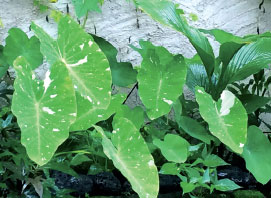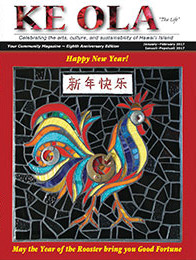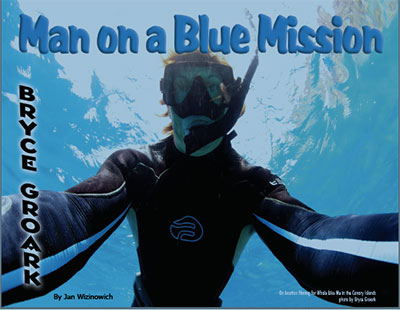
Ke Ola Pono: Feast or Famine
 By Leilehua Yuen
By Leilehua Yuen
In the Northern hemisphere, the season of feasting is over and we are now heading into a more ascetic phase. Whether this is through religious doctrine, or simply following the cycles of nature, it still holds true. However, sometimes we continue to act as though the feasting part of the cycle lasts all year long!
In ancient times in Hawai‘i, the ‘aha‘aina (feast) provided comfort, community bonding, and communion with the gods. Food was, and is, a blessing which should be celebrated. As in so many other cultures, a full ‘ōpū, (tummy), gives feelings of conviviality, and so community ties are enhanced through the sharing of meals. The ‘aha‘aina (today often called a lū‘au) is a community event, from the preparing of the food to the eating and entertainment. In ancient times, this conviviality extended to the gods. Even after the offerings were made, a sense of the gods’ presence remained through the feast.

Wasting food was considered hewa, a terrible offense. Sayings addressed this: “Mai māuna wale i ka mea ‘ai o huli mai auane‘i o ka ‘ai e pāhenehene.” If you waste food, some day it will turn and laugh at you. “Mai ho‘omāuna i ka ‘ai o huli mai auane‘i o Hāloa e nānā.” If you waste food, perhaps Hāloa will turn around and stare at you. The idea of these sayings being that if the food was wasted when abundant, then when it was scarce it would be unobtainable.
Thankfulness for having sufficient food to eat is also highly valued in traditional Hawaiian culture. “‘Ai a manō, ‘a‘ohe nana i kumu pali.” When a shark eats, it does not bother looking at the foot of the cliff–where the food came from.
These same concepts can be found in many cultures. My Irish/English grandmother used to say, “Waste not, want not,” and, “Use it up, wear it out, make it do, or do without.” Some other Irish sayings about food are: “A king’s son is not nobler than his food,” “A long fast and want of shoes makes young folk sensible,” and “Those who neither work, nor pray, shall starve.”
Our parents and grandparents who lived through the Great Depression had a deep understanding of the importance of respecting food. I remember being told to “Clean your plate! There are starving children in China!”
The more ascetic missionaries, who arrived in 1820, were not as given to celebration as to commemoration. Fasting was a large part of their tradition. Rather than communing with the gods through sharing in and celebrating the physicality of appetites, communion was achieved through denying the body’s appetites and mastering them. In fasting, the body’s changing chemistry can give a sense of euphoria which can lead to a stronger spiritual/religious experience. Many Hawaiian people who converted to Christianity began to practice fasting in addition to the traditional feasting.
Though famines were common in ancient times, and noted in many mo‘olelo (stories) and ka‘ao (legends) today, most of us have never known what it is to go hungry because there is no food. We have a steady supply which fills our grocery stores and can easily be brought home. Restaurants and fast food outlets surround us, so we tend to eat as though every day is a feast day. This has resulted in a lot of food-related disease.
We can reverse this trend in a number of ways. One is to re-examine the diet of our ancestors. Before the introduction of Western food and eating habits, Hawaiian people were noted by the earliest visitors to the islands as being tall, muscular, graceful, and stately. In 1779, Capt. James King wrote, “The natives of these islands are, in general, above the middle size, and well made; they walk very gracefully, run nimbly, and are capable of bearing great fatigue.” Nimble and able to bear great fatigue! All of us should be so!
In ancient times, the Hawaiian diet was based on vegetables and complex carbohydrates. Kalo (taro) corms, ‘uala (sweet potato) tubers, and ‘ulu (breadfruit) provided most of the calories. Lū‘au (young taro greens), lau ‘uala (sweet potato leaf), and hō‘i‘o (fern fiddleheads) were eaten in large amounts. Limu (seaweed), fish, and fruits were eaten as relishes to add flavor and variety. Birds were caught to eat fresh for special occasions, or salted and dried for use when other foods were hard to come by. Pork and dog were rarely eaten, and then generally only at high state occasions conducted by chiefly people.
Another important part of the traditional diet is that sense of communion with community and higher power. In the 1990s, Dr. Terry Shintani and his team developed the Wai‘anae Diet Program which many Native Hawaiian people found to be life-changing. One of the foundational practices in the program is before eating to express your gratitude “…and understand that you are connected to the ‘āina through the mana of your food.” I highly recommend the Wai‘anae Diet to anyone who suffers dietary diseases.
E ho‘i hou in nā ‘ai o nā kūpuna! Let us return to the foods of our ancestors!
Sources:
Pukui, Mary Kawena; Nānā i ke Kumu; Queen Lili‘uokalani Children’s Center
Shintani, Terry; The Wai‘anae Book of Hawaiian Health; Wai‘anae Coast Comprehensive Health Center
KaaheleHawaii.com
Contact Leilehua Yuen at Leilehua@LeiManu.com


